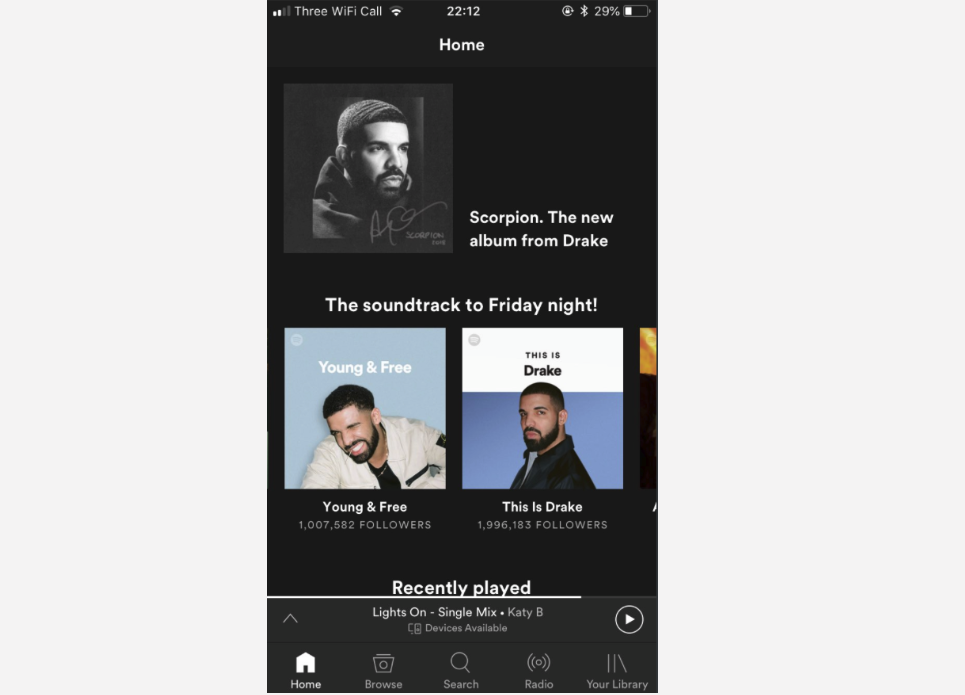
The release of a new Drake album was always going to be a big deal, with the hyperbolic narrative immediately being one of how it was going to “crush” streaming records. And it did. Of course it did.
Scorpion – all 25 tracks of it – landed on streaming services on 29th June and saw something on a PR war between Apple Music and Spotify as to who was going to be the driver of the most streams in the crucial opening days.
Apple, of course, had a long and tight relationship with Drake, bankrolling his ‘Hotline Bling’ video among other things, so Spotify had a lot to prove here. (Apple Music, despite having considerably fewer users globally than Spotify, came out the victor in the first tally of streams, which possibly says less about total market size and more about the genres and acts that land best with their respective userbases. No matter…)
It is fair to say that Spotify threw everything at the launch of Scorpion. Opening the Spotify app on the first few days of the album’s availability, users were bombarded with all things Drake. There was a marquee alert telling you the album was out, but despite navigating past that you found that the new album was top of the home page, along with a variety of Spotify-owned playlists with his face on the cover (including This Is Drake, Who We Be, RapCaviar, Summer BBQ, The Pop List, Summer Party, You Can Do It and Massive Dance Hits).
It was all, frankly, overwhelming. It was clearly designed by Spotify to show what it could do when it really got behind an artist or a release (it wasn’t called its first “global dedicated artist takeover” for nothing). But the knock-on effect and fall out went beyond jokey tweets from users feeling it was a bit much and escalated to outraged Spotify Premium users complaining that this was basically an unwelcome ad blitz when they had specifically subscribed to the service to remove ads.
Some users on Reddit claimed they issued a complaint to Spotify’s customer service department and were refunded the cost of their monthly subscription. Billboard, however, reported that Spotify was saying complaints were minimal and other sources were suggesting there was no refund policy.
It had people reaching for comparisons – and many alighted on the disastrous giveaway of U2’s Songs Of Innocence on iTunes in 2014. That promotion basically installed the album on every registered iTunes user’s collection and the outcry was such that Apple had to quickly release a workaround that let people zap the album from their libraries if they wanted to.
This move by Spotify was not the same as an album being installed in your library – as it was just a series of Drake-heavy playlists being served up to everyone for a few days. Users could easily skip past them and play whatever they wanted. But it all begs bigger questions about the ace in Spotify’s pack – namely its highly personalised recommendation system (seen at its best on Release Radar and Discovery Weekly). Scorpion did not build its nest in these playlists, but many Spotify users who – despite him being the most played act on the service with 54.7m monthly listeners and 22.6m followers – never play his music were left wondering why an artist they had previously shown zero interest in was being pushed so aggressively towards them.
It is all a classic “learning curve” for Spotify and its users here; but it is also a timely reminder of the echo chamber that can sometimes take over the music industry. Just because labels and services are excited about a big release and feel it deserves all the bells and whistles they can tie to it, it does not then follow that the public will a) be interested or b) capitulate in front of such a heavy marketing onslaught.
Project Budget
Target Age Groups
Demographics